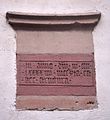Martinskirche (Grünstadt)
|
Martinskirche from the north-west |
|
| Basic data | |
| Denomination | Protestant |
| place | Grünstadt, Germany |
| Patronage | Martin of Tours |
| Building history | |
| construction time | 1617-1618 |
| Building description | |
| Architectural style | Baroque |
| Construction type | Saalau |
| 49 ° 33 '45.4 " N , 8 ° 9' 51.6" E | |
The Protestant Martinskirche is the landmark and with its 60 meter high tower it is also the tallest building in Grünstadt .
history
Green City was first mentioned on 21 November 875, when King Louis the German the abbey Glandern at Metz refunded this Hofgut. The location is already mentioned in this document "Grinstat" and the property rights are older, as they are only being restituted. This settlement was much older than the document from 875, which says nothing about the building stock. The assumption is made from a cloister courtyard with a small church, from which, via a Benedictine provosty, the modern Protestant St. Martin's Church with the burial place of the House of Leiningen-Westerburg developed several times . The patronage of St. Martin of Tours was taken over by the monastery church in Glandern.
The old Martinskirche in Grünstadt first appears in a document in 1121. In a document from 1212, Bishop Luitpold von Worms affirmed the Glandern monastery rights to the Martinskirchen in Grünstadt and Mertesheim and allowed them to use their inclines for its benefit. This document is confirmed by another document from Pope Honorius III. , exhibited in the Lateran , on March 27, 1218. Instead of the original church, which was probably built around 1000, a late Gothic church was built between 1493 and 1520 by order of the Glandern Abbey , the building inscription from 1494 still preserved. The construction work was outsourced to a foreman from Frankfurt , so the Gothic church building can be assigned to the so-called Frankfurt School on the Middle Rhine. In 1549 the church is described as "dilapidated". It has been Protestant since 1562, later it was temporarily a simultaneous church. In 1617/18 the current tower was built up to the height of the gallery.
The church was badly damaged in 1689 in the Palatinate War of Succession . Including the old tower, Count Georg Hermann zu Leiningen-Westerburg (1679–1751), who also laid the foundation stone, built a new nave between 1726 and 1736. The spacious church received five window axes and a chancel closed on three sides. In 1738 galleries were built and in 1743 the tower was raised. In the floor to the south and north of the choir there are entrances to the tombs of the Counts of Leiningen-Westerburg-Altleiningen and Leiningen-Westerburg-Neuleiningen located under the church. They have been opened and examined or renovated several times. Historical relics recovered in the process are exhibited in a museum room in the northern church annex. About the last examination of the count's corpses by Günter Herrmann from the district hospital Grünstadt and Per Holck from the University of Oslo in 1999, the book "The Leininger Grüfte in the Martinskirche zu Grünstadt" was published .
On December 6, 1942, the church burned down completely after an air raid. The reconstruction, which began in 1951, ended in 1963 with the erection of the spire. The pulpit by the sculptor Otto Rumpf has stood in the church since 1958 . In 1986 the facility was completed. The wall paneling was designed in memory of the earlier pulpit canopy as a back wall with a semicircular gable. The picture of Luther by the painter Johann Adam Schlesinger , saved from the fire, has found a worthy place here. Near the main entrance there is a charred offering box from the 17th century, which was rescued from the burning church in 1942.
Under the sacrament implements there is a bread plate, from the top of which four coiled rods rise and support a flat canopy on which the Lamb of God rises. The work was made by a silversmith in Worms with the master's mark HS in a rectangle. It was donated by Countess Margaretha zu Leiningen. A cup of gilded silver donated Johanna Dorothea zu Leiningen. Fine chasings can be found on the shaft and on the node as well as on the profiled edge of the calyx base. The maker's mark “IIH” does not allow any attribution. Two large, silver communion jugs are donations of the local brewery owner Johannes Jost (1850–1916).
At the old rectory in Boßweiler , the late Gothic sacrament niche of the old Martinskirche is walled in as a spoil. Its creation is dated around 1500.
Late Gothic sacrament niche in the old Martinskirche, now walled in at the former rectory in Boßweiler
Epitaph Schultheiß Johann Conrad Fabritius († 1722)
literature
- Richard Hummel (ed.): Architecture in the Evangelical Church of the Palatinate. Speyer 1988, ISBN 3925536116 .
- Ludwig Blankenheim: From Grünstadt's past days. Rheinpfalz Verlag, Ludwigshafen 1955.
- Walter Lampert: 1100 years of Grünstadt. Stadtverwaltung Grünstadt, 1975, pp. 34–39 and 317–319.
Web links
Individual evidence
- ^ Franz Xaver Glasschröder : Documents on the Palatinate Church History in the Middle Ages , Munich, 1903, pages 193 and 195, document registers no. 456 and 459
- ↑ Website about the examination of the bones by Prof. Holck and Dr. Herrmann
- ↑ Günter Herrmann, Per Holck, Horst Wilhelm: "The Leininger Grüfte in the Martinskirche zu Grünstadt" , Prot. Kirchengemeinde Grünstadt, 2000, ISBN 3-00-007212-8 (find information)
- ↑ State Office for the Preservation of Monuments: The Art Monuments of Bavaria , Administrative Region Palatinate, VIII. City and District Frankenthal, Oldenbourg Verlag, Munich, 1939, page 159







